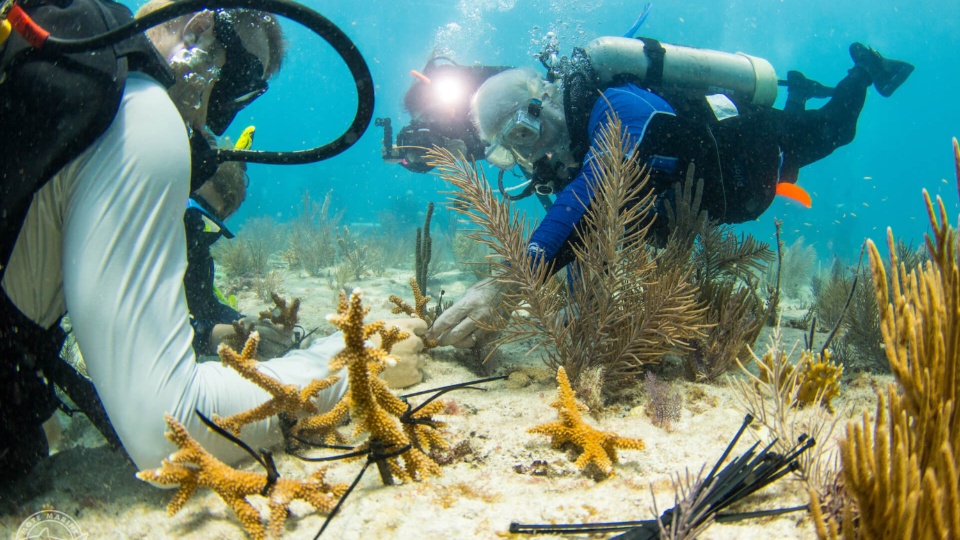
This past summer was a particularly cruel one around the globe when it comes to the climate crisis: Wildfires and rising sea temperatures have left many dead and local economies devastated. The question, “What can be recovered?” seems a foolish one as we transition out of summer into the fall, since those in the southern hemisphere are now preparing to face what we just experienced.
With record sea surface temperatures being reported this year off the coast, Florida’s Coral Reef has once again experienced a massive bleaching event. This has not only set the dying reef back—coral reefs being ecosystems that thousands (if not tens of thousands) of species of marine life depend on—but also sunk years of research and progress made by coral reef restoration scientists trying to revive it.
Knowing that the worst could still hit those in the South Pacific later this year, it seems less appropriate to designate this as “climate change;” it’s more like an “ecological catastrophe.”
“We had a major thermal stress event this summer, which we started getting the initial signs of as early as late May,” Dr. Jason Spadaro of Mote Marine Laboratory told People’s World. “We knew we were in for a rough summer.
“We were in an El Niño year, and without the Trade Winds disturbing the surface of the water, there was nothing to ameliorate the heat coming from unseasonably high temperatures and solar radiation,” Spadaro explained. “With the high temperatures and lack of wind, we were expecting an above average bleaching event, but we were not expecting it to show up as early as late June/early July.”
Spadaro is the Coral Reef Restoration Research Program Manager at Mote. Based out of the Summerland Key facility, Spadaro oversees all restoration activities in the Florida Keys.
Just how high these temperatures got is perhaps the most staggering part about this: “One sea surface temperature reading—albeit, in a backwater lagoon acting as a giant heat sink—reached 101 degrees Fahrenheit. That is the highest sea surface temp ever recorded on Earth at this point.
“This was not indicative of the temperatures on the Reef, but it wasn’t far off either,” Spadaro added. “In the middle of July, temps out on the Reef were in the mid-90s. Once we get above 87-88 degrees, we start seeing thermal stress, which can lead to bleaching; but, it’s not just the magnitude of the temperature, it’s also the duration.”
Surface temperatures that led to this stress started in July and did not relent until early October. With such prolonged exposure to this kind of heat, it is no wonder that this year’s bleaching event was devastating to the Reef and those who have tasked themselves with saving it.
All seemed lost this summer and much of the reporting on the bleaching event left little more than a pessimistic aftertaste. One had to dig deep for any glimmer of hope, but the truth of any possible miracles to come exists in the work.
“A lot of what is being reported is that everything is dead, 100% of the coral is bleached, but that is just not the case,” Spadaro explained. “Mote’s entire restoration strategy is founded on the principle of resilience, and we know based on decades of research into coral biology and ecology that many of the species here have traits that convey resilience to thermal stress, ocean acidification, and diseases, among other stresses.”
Having the chance to see this principle—and those traits—in action, Mote observed that not all of the corals on the reef and in their nurseries, in fact, beached or died.
“Many of them did bleach or die, and it was certainly devastating,” Spadaro said. “But we saw evidence of the benefits of thermal stress resilience and genetic diversity out on the Reef. The majority of corals were bleached but not dead, and a number of corals were only partially or not bleached at all.”

This doesn’t mean that the solution is clear or that the work to be done is known either.
Unfortunately, this is just the—or, perhaps, another—beginning. As Spadaro notes, “Now that it’s starting to cool off, we want to look at the critters that bleached and recovered. We want to be able to explain why that was: Is it genetic resilience or is it some sort of environmental condition that we need to build into the physical restoration strategy?”
The difference between a bleached coral and a dead coral can be a confusing one when there is so much urgency put on the former, but this difference should not downplay its importance either.
“When a coral bleaches, it is spitting out all of its algal symbionts—the dinoflagellates that live in the coral tissue that allow them to do photosynthesis and give them compounding epigenetic features like resilience to heat or solar stress,” Spadaro illustrated.
“Corals are exciting because not all of the symbionts are the same, and if a coral bleaches, it does not need the same algal composition to recover and can look to other symbionts that might give some resilience where the previous symbionts didn’t.”
This symbiotic relationship is important to corals for various reasons; one of importance is that through photosynthesis, the algae can generate food for the coral. There are trade-offs here, as well. As Spadaro pointed out, if one symbiont is more efficient at photosynthesis, it may sacrifice this for one that is more thermally resistant.
“We also look at how to integrate this into our restoration strategy so that the coral can deal with the stresses we saw this year, which were some of the worst we have seen, and the stresses we haven’t planned for yet that are 25-50-100 years down the road,” Spadaro added.
Although Mote was able to scrape some hope out of the bottom of the barrel for the rest of us, we are far from being on a straight path of progress, let alone one that can be set by such trailblazing scientists. One cannot help but wonder at the effort it takes to continue working after such a potentially catastrophic event: How does the scientist push the same boulder over another hill?
“We don’t have to hope—we know, based on our scientific data, that the corals can resist these kinds of stresses,” Spadaro said. “They will persist through time.”
But will the scientists persist? What makes such a discipline even approachable, knowing that one is already late?
“For many people, there was this eco-grief that was experienced during and after the bleaching event. That’s many years of research and effort as well as an iconic ecosystem that might have been completely wiped out. It’s obviously depressing, but, as a restoration ecologist, you’re coming into a field that, in order for it to be in existence, catastrophic events must have happened,” Spadaro explained. “That is just our way of life.”
The restoration scientist makes a good case not just for the ecological dilemmas of our era, but those of any era—especially those considered to be lost causes.
He went on to add: “Solving these very complex and crucial questions, working with that race against time, while responsibly assisting with the evolution of an entire community of organisms, that is what gets us out of bed in the morning.”
Nevertheless, we are not out of the heatwave that led to the bleaching event, per se. It has only “left” our part of the world, and what is to come remains to be seen. Mote has been working with scientists around the globe to not only reverse the Reef’s impending extinction but also to share strategies in other parts of the world, most notably The Great Barrier Reef in Australia.
“It was definitely the canary in the coal mine,” Spadaro said. “It raised the alarm that this year is going to be rough. It gave our colleagues in Australia and the South Pacific a lot of lead time to prepare. This is a global issue—not a local or regional one.”
Such global solidarity is what’s needed now more than ever when tackling larger-than-regional questions stemming from environmental concerns that we cannot keep ignoring. Not all the lessons learned from this year’s temps and bleaching only apply to restoring Florida’s Coral Reef, and it is with the utmost urgency that we start seeing the universal quality and innovation in restorative work.
Spadaro offered up a different reading of this summer out on the Reef, which is a helpful reminder to anyone even remotely interested in the waters off our southern coast: “It really was a destructive event, but there is a bright side: This wasn’t the end of the story of Florida’s Coral Reef.”
Visit mote.org/savecoral to donate.
We hope you appreciated this article. At People’s World, we believe news and information should be free and accessible to all, but we need your help. Our journalism is free of corporate influence and paywalls because we are totally reader-supported. Only you, our readers and supporters, make this possible. If you enjoy reading People’s World and the stories we bring you, please support our work by donating or becoming a monthly sustainer today. Thank you!










